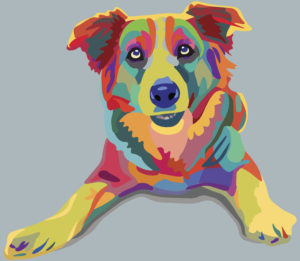 In my professional work, I see families whose lives have become challenged beyond their abilities to cope, by the behavior and perceived emotional status of their pet. The family’s fingers typically point to the family dog or dogs, but can often involve cats, or other animals kept as household pets. I hadn’t seen a pot-bellied pig since the 1980s, until my recent visit to an urban mansion turned hog barn. The main-floor’s furniture and floors were destroyed, along with substantial damage to drywall and woodwork. Having never had any family pet in the 23 years they had been a family, the family’s attempts at training were completely unsuccessful.
In my professional work, I see families whose lives have become challenged beyond their abilities to cope, by the behavior and perceived emotional status of their pet. The family’s fingers typically point to the family dog or dogs, but can often involve cats, or other animals kept as household pets. I hadn’t seen a pot-bellied pig since the 1980s, until my recent visit to an urban mansion turned hog barn. The main-floor’s furniture and floors were destroyed, along with substantial damage to drywall and woodwork. Having never had any family pet in the 23 years they had been a family, the family’s attempts at training were completely unsuccessful.
“Oh, so you are like the Dog Whisperer,” my new acquaintances insist.
“No, not at all,” I counter. “We are a professional animal behavior practice that works to make human lives whole around their pet’s unacceptable emotions and behavior. No blaming, no shaming, we offer pragmatic evidence based interpretations and solutions.
The pig is a perfect segue to discussing this difference.
Regardless the nature of my visit – aggressive behavior, affective (emotional) disorders, learning impairments, sensory and physical impairments, geriatric issues – each having the capacity to influence behavior in, for the family at least, less than desirable ways, families universally want me to know and believe that they do exercise their dog! And, often to tortuous levels of endurance and exhaustion, only to come home and have the animal behave inappropriately, again.
The funny thing is that I never asked about exercise and probably wasn’t going to.
The clear majority of new clients come to me after exhausting other options at their disposal to remedy their problem. Most of whom have been browbeaten along the way by amateurs and professionals alike for not following directions, not being assertive, not providing enough exercise.
 Even the family of the pig-in-a-mansion assured me that they had watched the “Dog Whisperer,” but that they couldn’t keep the animal in a harness and were afraid of taking it to the dog park and having it escape. Their premise for having me to their home was to show them how to “exercise all of the crazy behavior out of him.”
Even the family of the pig-in-a-mansion assured me that they had watched the “Dog Whisperer,” but that they couldn’t keep the animal in a harness and were afraid of taking it to the dog park and having it escape. Their premise for having me to their home was to show them how to “exercise all of the crazy behavior out of him.”
I whispered that we should instead be discussing an exorcism for the crazy people who thought that a pig is a puppy, without having any idea of what entailed a puppy. The pig was purchased online, on an impulse, while searching for a puppy to buy online, on an impulse. The rest is a story for another time. Spoiler alert: they all lived happily ever after.
I’m not typically comfortable disparaging others in the business of animal behavior, but rarely a day goes by that I am not reminded of the now decade old New York Times article, Pack of Lies, by Mark Derr. But, to ignore the teachable moment afforded by the inquiry of the ill-informed is a disservice to them and the dogs they influence.
No more whispering.
Crude, yet often effective basic training, harmful and potentially dangerous concepts and techniques for addressing inappropriate behavior; these are what I know of the famous Dog Whisperer’s lessons. Too, his blame the victim message to owners of dogs gone wrong doesn’t ring true to me, as I rarely see cases that are not largely due to the misfortune of having selected a maladaptive pet in the first place.
Sure, we see families that are clueless as to what to expect from a relationship with a completely normal dog, and admit that they don’t know where to begin. For these responsible owners, we offer educational options to assist them.

Dogs are not wolves. They are very specialized canines that have been intentionally bred for our pleasure, to serve as our companions, sentries, servants, and surrogates. Most are sweet natured and needy for our affection and approval, making them easy to manage and train. This is largely due to 15,000 years of selectively breeding qualities of neoteny: juvenile characteristics that persist throughout the lifespan of the animal. Dogs are supposed to be long-lived puppies. Yet, some possess biological mistakes and behavioral predispositions that preclude them from easily fulfilling the promise of faithful urban companions. Fewer still simply are not domestic candidates at all. Still others are difficult to manage as pets because of bad approaches we use to teach them, resulting in both confusion about and mistrust of people and the environment.
Cookie cutter approaches to treating aberrant behavior don’t cut it.
At best, when applied by an educated practitioner who can foresee and avoid potential danger to the animal and others, training methods as treatment can be useful as tools for making a differential diagnosis. If the training gives acceptable results that’s great, but failures are good news too, when deconstructed against sound hypotheses for cause.
 The same is true in the use of psychotropic drugs to manipulate an animal’s emotion and behavior. Use of SSRIs and certain benzodiazepines, as example, in the treatment of fears, hyperactivity, and aggression can lead to catastrophic results as these drugs can temporarily mask symptoms or produce paradoxical results, thereby leading to a complacent owner exposing the animal and public to a game of canine-Russian-roulette.
The same is true in the use of psychotropic drugs to manipulate an animal’s emotion and behavior. Use of SSRIs and certain benzodiazepines, as example, in the treatment of fears, hyperactivity, and aggression can lead to catastrophic results as these drugs can temporarily mask symptoms or produce paradoxical results, thereby leading to a complacent owner exposing the animal and public to a game of canine-Russian-roulette.
Many of these new pharmacologic silver bullets come with short windows of opportunity for accomplishing behavior modification under the effects of the drug and before irreversible behavioral tolerance becomes established within the physiology of the central nervous system. In short, the benefits of the drug are short lived without adequate supervision, titration, and concomitant behavior therapy and management.
I have enjoyed much satisfaction and success for over 30 years working with pets in the homes of families in the Great Lakes Region. To date, our practice has seen clients from 9 states and Canada. I operate a clinical house call practice for behavior problems in pets, a residential training and treatment facility, and a small family-centered training school. Unlike my contemporary, Cesar Millan, my experience doesn’t suggest that men are any better than women or children at controlling dogs. In fact, my experience shows that young adolescent children with the support of an adult make the best trainers of young dogs. The reasons for this are best the subject of another discussion.
We see a significant number of clients who are elderly, have disabilities, or whose personalities are at odds with the rigorous demands of the methods dictated by the
Dog Whisperer.
Instead of demanding that owners be and do things they are often incapable of, such as forcibly and physically intimidating the dog, or exercising it to extreme, we work to foster pro-social attitudes and behavior in people and pets alike.
For behaviorally and developmentally “normal” dogs we provide academically sound and humane training methodologies that build attachment, cooperation and manners.
For more challenging pets, we identify the root causes of unacceptable behavior and emotional states, recommend and oversee treatment paradigms to normalize these attributes in the pet, and then apply appropriate methodologies to build attachment, cooperation and manners.
I am an animal behaviorist. I apply the principles of ethology, biology and socio-biology, learning theory, emotion and motivation, and developmental psychology to the observation and interpretation of behavior, with the goal of helping families humanely achieve a human–companion animal bond experience that is rich with purpose and value.
So, please don’t call me the Dog Whisperer, unless you’d like me to raise my voice.